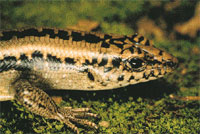A zoologists dream
A zoologists dream

With Vietnam slowly opening up to Western scientists in the last decade, numerous organisations have been vying with each other to study the country's flora and fauna. After Ho Chi Minh ousted the French in 1954, Vietnam's leaders closed the country and its forests were effectively locked to outsiders. Even after the end of the debilitating us -Vietnam conflict, the region elicited little external biological interest. The situation changed dra matically in 1992 when British scientists discovered the sao la . The international biological community was shocked: How could a large hoofed animal remain anonymous until now? Vietnamese authorities were soon deluged with biologists from around the globe seeking permission to enter the nation.
Says herpetologist Leslie Anthony in an article in the Canadian magazine Equinox , "Our quest is many a zoologist's dream: a chance to find and identify undiscovered animal species in a remote corner of the world. At first every animal resembles a leaf or twig: frogs, snakes, lizards, insects of every stripe, and even butterflies pass themselves off as vegetable matter. There are snakes that look like worms and worms that look like snakes and lizards that look like both. We find all in Tam Dao, but what really makes our headlamps spin is the incredible diversity of frogs. Tam Dao was scoured earlier in the century by French herpetologist Rene Leon Bourret. Yet Nikolai Orlov, a veteran of several Russian-Vietnamese expeditions, finds that little is known about the frogs even in such comparatively well-studied areas. This theme is repeated everywhere we collect, and it quickly becomes clear that there is enough work here to occupy several generations of taxonomists. Back in Canada, Royal Ontario Museum (ROM) entomologist Doug Currie finds that in the residue from just one of his flying-insect traps, 13 of the 14 species of tiny flies are new to science. It seems we are only scratching the surface. Doug believes that the Vietnamese estimate of 5,000 species for their country is off by several orders of magnitude. Our short stay in Tam Dao, in fact, uncovered significantly greater diversity than previously imagined.' What is more amazing is the fact that the Vu Quang forests have been logged over once before, and yet they are revealing such amazing diversity today. Anthony accompanied Bob Murphy, curator of herpetology at ROM, and eminent Russian herpetologist Ilya Darevsky from the Russian Academy of Sciences' zoological institute in St Petersburg, to the area where the sao la was discovered in late 1994.







